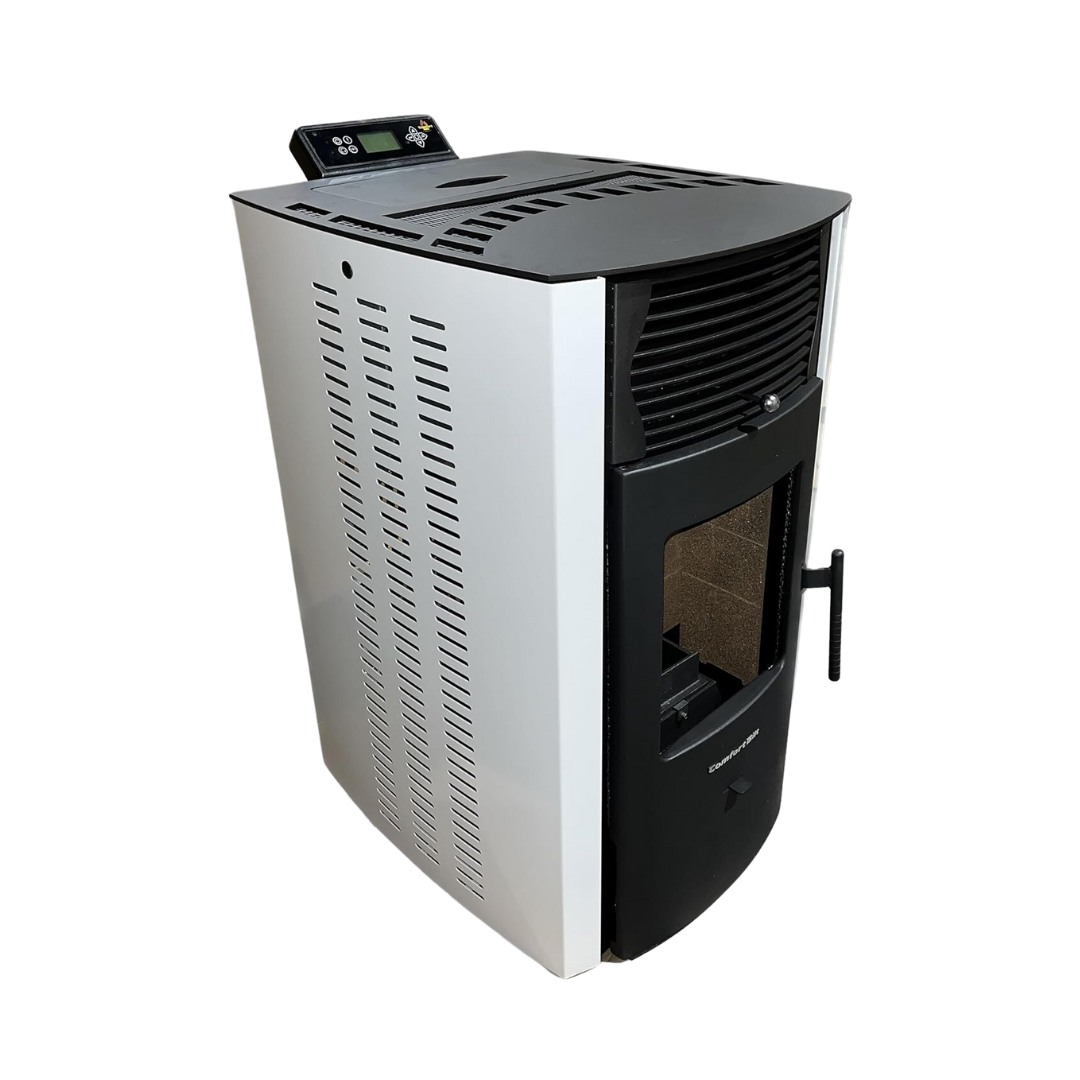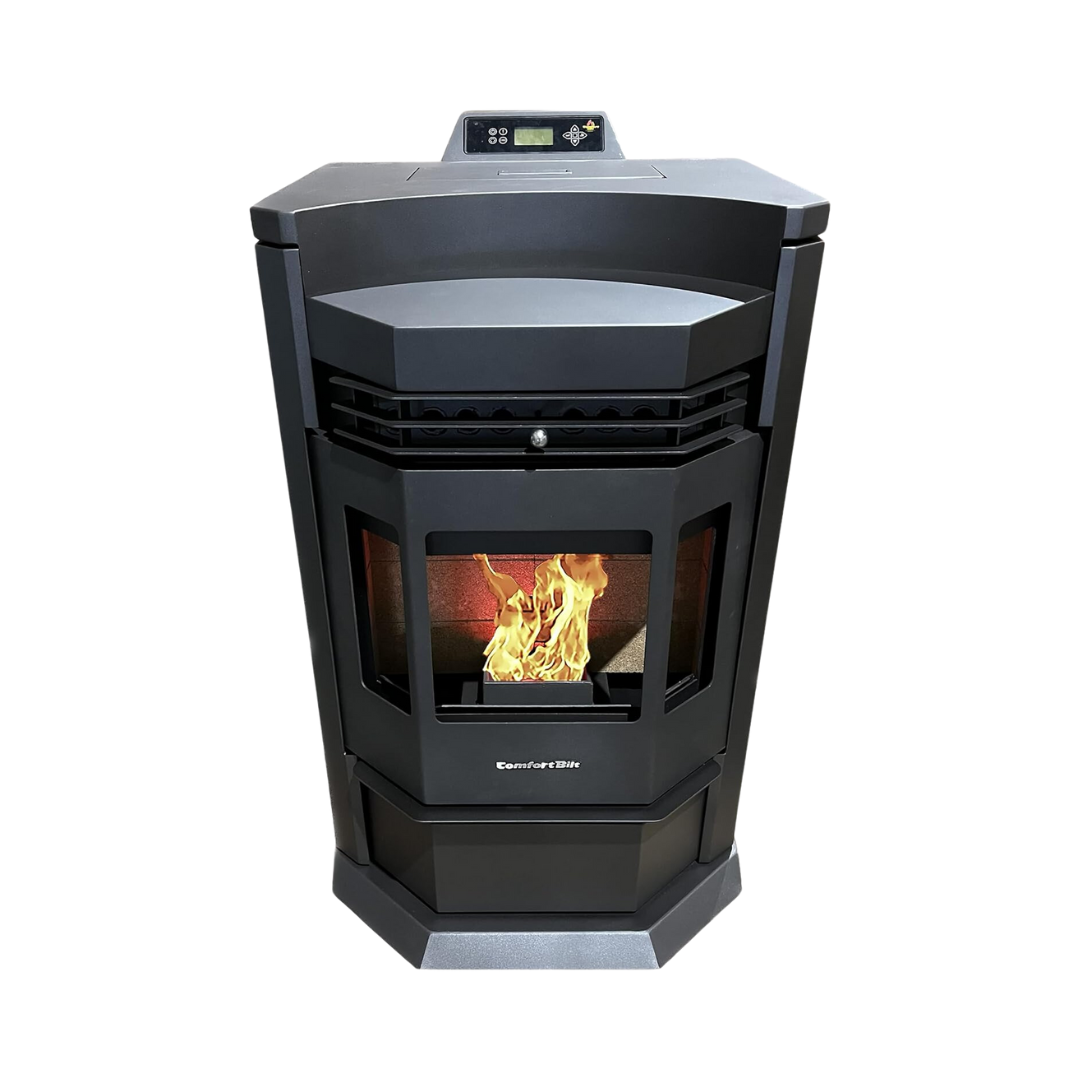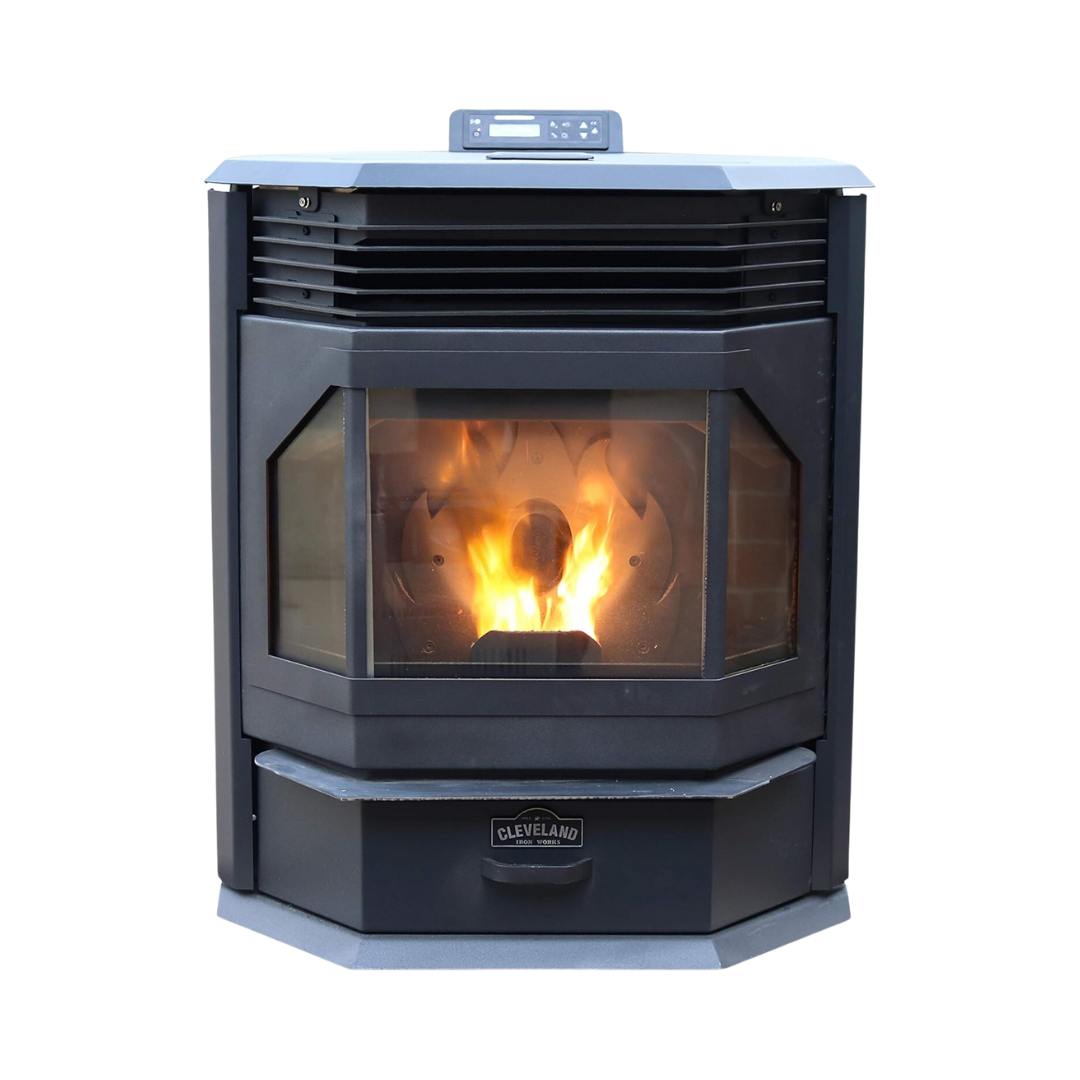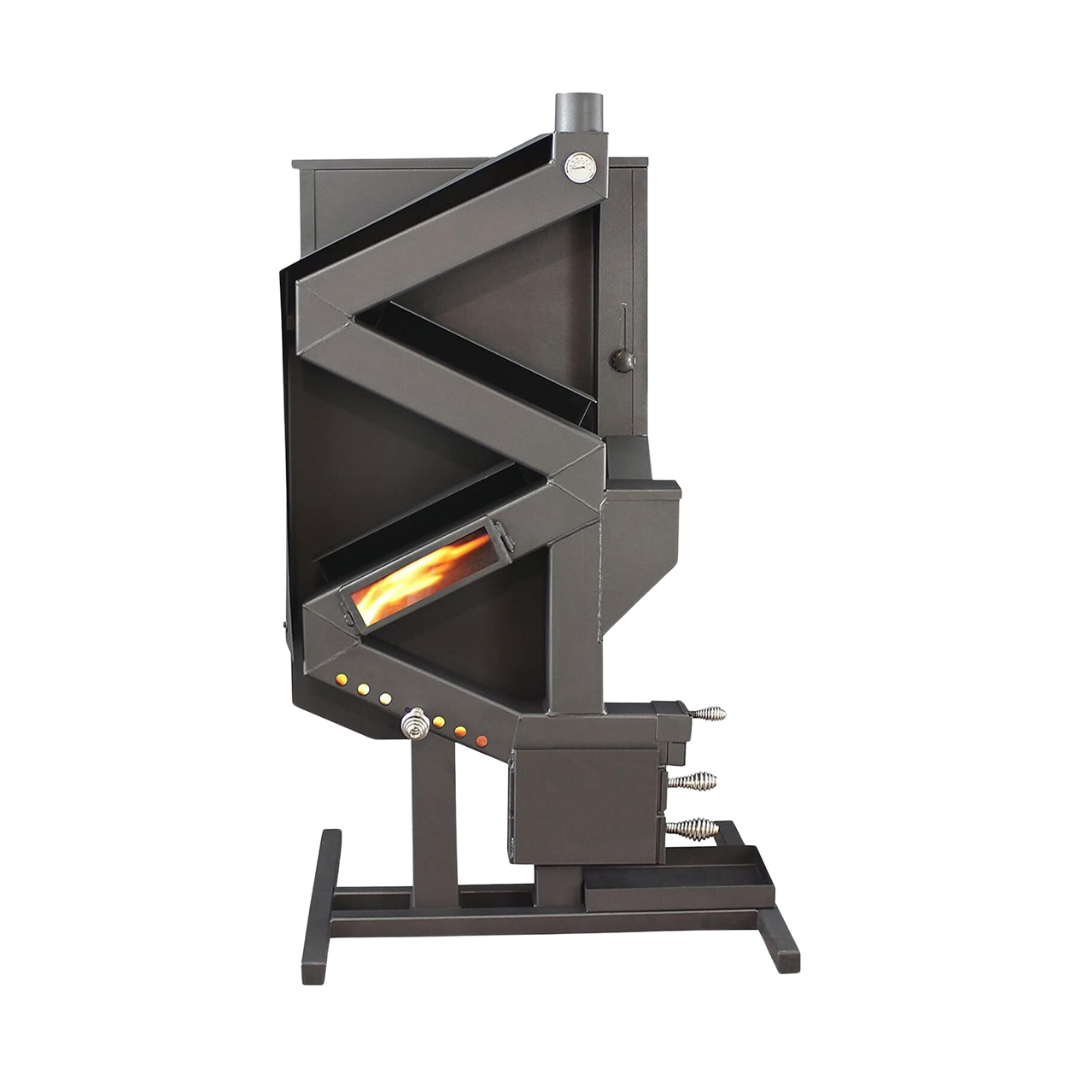We may be compensated if you purchase through links on our website. Our team is committed to delivering honest, objective, and independent reviews on home products and services.
In This Review: Top 4 Picks | Buying Guide | Types of Pellet Stoves | FAQ | Methodology
Many people heat their homes with pellet stoves because they find them more convenient and efficient than wood stoves and fireplaces. A pellet stove has the same cozy and attractive look as a traditional wood-burning stove, but offers cleaner burning with less air pollution.
Overall, investing in a pellet stove can cost anywhere from $1,600 to $5,000. Professional installation is generally recommended to ensure that ventilation and carpentry work are handled correctly.
In order to help you bring this efficient and cozy option to your home, we researched top-rated pellet stoves. Our top choice among the best pellet stoves is the ComfortBilt HP50S Small Wood Pellet Stove. With a sleek design and vent-free operation, this option delivers an easy way to enjoy up to 20 hours of continuous burning. Take a look at our guide below for more of our picks.
Best Pellet Stoves: Our Top 4 Picks
- Best Overall: ComfortBilt HP50S Small Wood Pellet Stove
- Best Heavy-Duty: Comfortbilt HP22-N Pellet Stove
- Best Smart Features: Cleveland Iron Works Bayfront Pellet Stove
- Best Non-Electric: US Stove Company Non-Electric Pellet Stove
Compare Top Pellet Stoves
| Product | Hopper Capacity | Heating Output | Heating Capacity |
|---|---|---|---|
| ComfortBilt HP50S Small Wood Pellet Stove | 20 lbs | 42,000 BTUs | 2,200 sq. ft. |
| Comfortbilt HP22-N Pellet Stove | 80 lbs | 50,000 BTUs | 2,800 sq. ft. |
| Cleveland Iron Works Bayfront Pellet Stove | 66 lbs | Not listed | 1,800-2,500 sq. ft. |
| US Stove Company Non-Electric Pellet Stove | 60 lbs | 40,000 BTUs | 2,000 sq. ft. |
| Product | Hopper Capacity | Heating Output | Heating Capacity |
Terms To Know for Pellet Stoves
- Hopper Capacity: The amount of pellets a hopper can hold in pounds.
- Heating Output: British Thermal Units (BTUs) are a measure of heat generation. Generally, 20 BTUs are required to heat one square foot.
- Heating Capacity: How large an area the pellet stove can heat, measured in square feet.
Best Overall
Good for: Someone looking for a quiet and efficient way to heat an entire home.
What Are People Saying About ComfortBilt HP50S Small Wood Pellet Stove?
Overall, we found that most customers are very happy with this pellet stove’s performance. Many were surprised by just how much heat such a compact unit can put out. However, a few shared that this stove eats more pellets than expected, and others had difficulty with getting it to maintain a consistent output.
“Best pellet stove I have ever seen. Heats so much better than the 2 other pellet stoves I had. Very quiet and heats up very quickly. Everyone raves about the heat output. Well built and very heavy-duty. I highly recommend this stove.” — Erin Pritchett via Amazon
“[…]When it works, it’s great; but it’s inconsistent at best. I’ve spent a lot of back-and-forth with technical support and have gotten to the point where I can keep it going most of the time, but it needs a lot more attention than I feel it should.[…]” — Ben, Your Friendly Tech Guy via Amazon
Best Heavy-Duty
Good for: People who like to “set and forget” with help from a large hopper.
What Are People Saying About Comfortbilt HP22-N Pellet Stove?
In our research, we saw that most customers were impressed by the quality of this stove. The stove also earns accolades for its powerful heat output and easy-to-clean design. Despite the stove’s large capacity, some homeowners were frustrated by how often they needed to refill the hopper.
“We bought this to replace an Englander pellet stove [that] came with the house, after mice got to one of our heat pumps. It’s getting us through the winter just fine. Heats our 1200 [sq. ft.] cape without issue. If anything it puts out too much heat. We have to turn it off occasionally when it’s 30F+ outside. The thermostat is great. Just set the temp and leave it alone. [The] dust pan is great. The stove’s super easy to clean. Our room fan was a little noisy and customer service replaced it immediately. No regrets. Would purchase again.” — Anon via Amazon
“Great stove that puts out a lot of heat but there are a few major design flaws. […] Design Flaw #1: The stove’s hopper design is such that it does not funnel the pellets to the auger properly causing it to run out with 25+lbs of pellets still in the hopper. […] Design Flaw #2- The door to fill the hopper is ridiculously small.
[…] I can live with the small door since that improvement is a ‘nice to have,’ but the extended 80lb hopper that is ‘supposed’ to run for 2-3 days without intervention that instead shuts down for ‘no pellets’ in a half day is a deal breaker for me. Especially knowing I spent the extra money to get that feature to not have to babysit is the killer.[…]” — EdV via Amazon
Best Smart Features
Good for: Someone who likes to manage indoor temperatures carefully.
What Are People Saying About Cleveland Iron Works Bayfront Pellet Stove?
While most people praise the tech on this pellet stove, some reviewers wished for a simpler interface. Several shared that this stove was great for hitting a temperature “sweet spot” quickly before leveling off to help cut energy costs. On the other hand, a few felt that this stove didn’t quite live up to its promises of heating more than 2,000 square feet.
“I’ve had this stove for over a year now. I burn right around 2 tons of pellets each season for my 1,800-square foot house. This stove does most of the work and we keep a small electric heater in each room that we fire up for a few minutes, right before bed. The amount of money I’m saving over our propane furnace is unreal. I have the stove set to come on automatically when the room hits a certain temperature and shut off when it hits another temperature, a feature I love. The glass does go black with soot very quickly, probably within a few hours.” — jill k smith via Amazon.
“Windows get black too fast. Flame gets out of control when starting. Awkward placement of on/off button and low placement of exhaust I’ll outport.” — Brian Desmarais via Amazon
Best Non-Electric
What Are People Saying About US Stove Company Non-Electric Pellet Stove?
We found that while customers generally appreciate the consistent heat and hassle-free design, a few had difficulties with controlling smoke. One tip that has been shared by reviewers is to use softwood pellets instead of hardwood pellets to get a hotter burn.
“Smokes a lot with bad fumes on first start up. Recommend running first outside. This stove heats really well. Easy to start but so far it would be nice if I could control heat a little better. I will update after in use for a while. Update: after using for a while it kept smoking in the house. It had a bad weld which I had someone fix for a small fee, Amazon helped with the cost. Really works great so far.[…]” — A Tanner via Amazon
“Like people have said, this stove will carbon up above the burn chamber and slow down pellet flow. I find I have to scrape this every week with a little hoe-looking tool I made.[…] It works good to keep my garage warm, but I would not recommend it as a primary heat source for your home.” — Doug Walker via Amazon
What Do You Need to Know Before Buying a Pellet Stove?
In order to find a stove that meets your needs, you need to understand how a stove would work in the specific space you’re trying to heat. This guide to the essential factors for finding the best pellet stoves is a good starting place.
Efficiency
Pellet stoves are already more efficient than standard wood-burning stoves. That’s because the low moisture in pellets allows them to burn more efficiently than wood logs. Pellet stoves also hold a distinct advantage over propane heating appliances as an energy-efficient and eco-friendly home heating solution due to their use of renewable fuel. Look for EPA-approved models that qualify your home for tax credits. All EPA-certified pellet stoves usually fall into the 70% to 83% efficiency range.
Heat Output
Heat output describes the amount of heat converted from the pellets you put into your hopper. Most manufacturers of pellet stoves list their heat output in BTUs. A higher BTU number means a higher heat output. With modern pellet stoves, BTUs can range from 8,000 to 80,000. If you’re looking to make heating your home as economical as possible, look for pellet stoves with eco modes that trigger the unit to shut off once a desired temperature has been reached. While in eco mode, a stove will also turn back on once the room cools to a set temperature.
Size
Always look at the dimensions of any pellet stove you’re considering before bringing it into your home. While newer compact models are making it possible to use pellet stoves in tight areas that never could have accommodated stoves in the past, you still can’t just “squeeze” a stove in anywhere it will fit. Always measure a space with the clearance needed in mind. Generally, pellet stoves need to be placed at least 3 feet away from any surfaces or objects to avoid combustion risks. Larger pellet stoves tend to have larger hoppers that can accommodate more pellets. Hopper capacity on standard pellet stoves can range from 18 pounds to 80 pounds. The advantage of choosing a larger hopper is that you won’t have to refill your pellets as frequently.
Maintenance
All pellet stoves require roughly the same maintenance protocols. The main issues you’re battling are soot and sawdust. To remove buildup, do a weekly brushing or vacuuming of the main burn chamber areas. One factor that does cause deviations for maintenance protocols among pellet stoves is the size of a design’s ash drawer. Stoves with larger ash drawers can go longer between cleanings. However, you should still clean an ash drawer thoroughly at least once every two weeks. Finally, pellet stoves with larger windows tend to require more maintenance because soot can fog up the glass pretty quickly.
Design
For many people, a new pellet stove is intended to be a focal point of a room. Most people look for a classic stove look that is indistinguishable from a wood-burning stove. For those looking for a modern design, gravity-fed pellet stoves have a vertical design that only shows off a small peek of the flames inside.
One design element to pay attention to is the pellet feed system. In a top-feeding pellet stove, pellets are placed into the auger from the top of the unit. Some people like this option because it reduces the risk of fire getting up into the hopper. It also generally creates better efficiency because pellets get burned fully. However, a top-feeding design does pose a higher risk for ash clogs. If you opt for a top-feeding pellet stove, commit to high-grade pellets with low ash levels. With a bottom-fed hopper, pellets are fed into the stove horizontally from the back of the fire. There’s more freedom to use standard pellets with this design because ash naturally moves away from the burn zone.
Types of Pellet Stoves
Pellet stoves can be freestanding or fireplace inserts. If you’re starting from scratch with heating your home with a pellet stove, a freestanding option offers easy installation with an exhaust pipe. If you have an existing fireplace that you’d like to convert, an insert-style pellet stove can fit into the firebox to vent up to your chimney.
Freestanding Pellet Stoves
A freestanding pellet stove consists of a cast-iron box unit that is either mounted on a pedestal or four furniture-like legs. As the name implies, it is designed to stand in a corner against a wall without being vented through a chimney. Generally, a freestanding pellet stove can be installed anywhere you have the room, clearance, and ability to connect an exhaust pipe. One of the biggest benefits of a freestanding pellet stove is that it’s easy to reach every corner for cleaning.
Wall-Mounted Pellet Stoves
Just like freestanding and insert pellet stoves, wall-mounted pellet stoves offer another versatile option for homeowners. As the name suggests, these units are mounted directly onto the wall, providing a space-saving solution for home heating. One of the significant advantages of a wall-mounted pellet stove is space efficiency. They don’t take up any floor space, making them ideal for smaller rooms or tight spaces. However, cleaning can be more of a challenge, and the installation cost is often higher.
Insert Pellet Stove
Insert pellet stoves can save space in your home if you already have an existing fireplace. However, one downside to an insert is that reaching different parts of the stove for cleaning can be challenging. Installation can also be more expensive.
Frequently Asked Questions About Pellet Stoves
How do you vent a pellet stove?
There are two main ways to vent a pellet stove. When installing a freestanding pellet stove without a chimney, a flue or exhaust pipe that is connected to an external wall of the home is used to send gas waste vertically up the side of the home to the outside. Insert pellet stoves vent through the chimney.
How much electricity do pellet stoves use?
According to the U.S. Department of Energy, pellet stoves consume about 100 kilowatt-hours (kWh) of electricity per month. This works out to about $9 worth of electricity.
What does hopper capacity refer to?
Hopper capacity describes the amount of pellets in pounds a pellet stove’s hopper can hold. Generally, hopper capacity ranges from 18 pounds to 80 pounds. A higher capacity means that a stove can burn for a longer time without the need to refill pellets
Our Methodology
This Old House has empowered homeowners and DIY-ers for more than four decades with top-notch home improvement advice in the form of television programs, print media, and digital content. Our team focuses on creating in-depth product and service review content. To date, we’ve published over 1,600 reviews on products in the home space, including power tools, outdoor equipment, major appliances, kitchen gadgets, electronics, and more that focus on product quality and helpfulness to our readers.
To provide our readers with the best recommendations possible, we rely on several key sources of information to help guide our selection process.
Initial Research: Our research process began by generating a list of pellet stoves with a significant number of verified buyer reviews and an average customer review rating of 4–5 stars. We looked at positive and negative reviews alike, focusing on information from both satisfied and critical buyers.
Expert Insights: To complement our in-house expertise, our team looked at reviews and videos from trusted publications and independent testers, spoke with subject matter experts, and drew insights from reader contributions.
Final Product Selection: We then began fine-tuning our list by replacing older models with the latest versions and eliminating any discontinued models. From there, we compared each model’s feature set to create a final short list, selecting the best-in-class options for various buyers, budgets, and scenarios.
Once we conclude our research, we craft a comprehensive, user-friendly article of recommended products and additional information to help our readers make the right purchase.
Questions or Comments?
To share feedback or ask a question about this article, send a note to our team at reviews@thisoldhousereviews.com.





